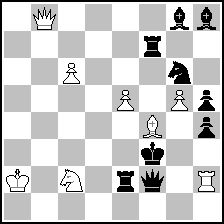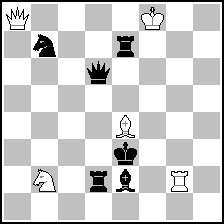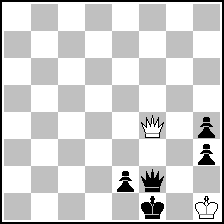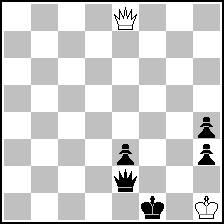
Website founded by
Milan Velimirović
in 2006
18:05 UTC


| |
MatPlus.Net  Forum Forum  General General  Marianka 2013 Marianka 2013 |
| |
|
|
|
|
You can only view this page!
| | | (1) Posted by Peter Gvozdjak [Sunday, Jun 2, 2013 15:58] | Marianka 2013
here is announcement of the traditional summer chess composition festival in marianka, slovakia:
http://www.jurajlorinc.com/chess/mari13be.htm
| | | (2) Posted by Juraj Lörinc [Monday, Jul 1, 2013 13:46] |
There will an interesting international participation in Marianka, many lectures by guests, already 6 lectures are promised, by Uri Avner, Georgy Evseev, Marian Krizovensky, Juraj Lorinc, Ladislav Salai jr. and Ivan Skoba. Other participants registered:
http://www.jurajlorinc.com/chess/mari13de.htm
Today the 30-day tourney for Marianka participants only was announced:
http://www.jurajlorinc.com/chess/macu13an.htm
But as in 2012, the fairy tourney will be open for e-mailing authors too, it will be announced on the July 31st and closing date will be August 3rd (evening).
| | | (3) Posted by Georgy Evseev [Tuesday, Jul 2, 2013 06:23] |
Are joint compositions with at least one author participating in festival allowed?
| | | (4) Posted by Linden Lyons [Tuesday, Jul 2, 2013 15:23] |
Will the theme of the fairy tourney for emailing authors be different to that of the 30-day tourney?
| | | (5) Posted by Juraj Lörinc [Tuesday, Jul 2, 2013 15:36] |
Georgy: Yes, joint compositions with at least one, but not necessarily all their authors present in Marianka are allowed. I hope to add that into original announcement later today.
Linden: Yes, 4-day fairy TT Marianka will have different theme. (As its judge I have already selected the theme, I hope it will be liked equally by help-, self- and direct- problem authors.)
| | | (6) Posted by Juraj Lörinc [Wednesday, Jul 31, 2013 11:35] |
4-day fairy TT Marianka 2013 open for e-mailing authors is announced. Details at: http://www.jurajlorinc.com/chess/ma13faan.htm
Shortly, the theme is "duel of two pieces, at least one of them should be fairy piece".
Seven examples from CCM are referred to in the announcement, further nine examples provided to Marianka participants with the announcement there are at CCM too: http://www.jurajlorinc.com/chess/duelfapi.htm
Note the deadline for e-mailing authors - July 3rd,18:00 (CEST).
| | | (7) Posted by Branislav Djurašević [Saturday, Aug 10, 2013 13:23]; edited by Branislav Djurašević [13-08-10] |
I have been at 5th Marianka 2013 Meeting. It was organized very well with many problemists from abroad (even from nine countries). The Meeting started with minute of silence in the memory of Milan death. Thanks to the organizers for all. When I came back I just have seen that also MatPlus Forum works again. So, my heart is full of joy.
| | | (8) Posted by Ivan Skoba [Sunday, Aug 11, 2013 10:20] |
For complementarity of my lecture in Marianka I would be glad to find list of all entries from 2nd WCCT C 15.2.1981 - Section G1. Especially two of them. They are not included in Final Result.
Do you know anybody who can help?
Ivan Skoba
| | | (9) Posted by Ivan Skoba [Sunday, Aug 11, 2013 10:22]; edited by Ivan Skoba [13-08-11] |
For helpers I will specify my wishes via e-mail ...
| | | (10) Posted by Peter Gvozdjak [Tuesday, Aug 20, 2013 20:54] |
here we start the series of lectures.
the first of them (by uri avner) is published:
http://www.youtube.com/watch?v=RHcJ1a3GXKs&feature=youtu.be
enjoy!
| | | (11) Posted by Eugene Rosner [Wednesday, Aug 21, 2013 15:16] |
Many thanks Peter!! great to see Uri in a "live" broadcast! Brings back my own memories of meeting him in Isarel in the summer of 1989. Now that also goes back a while!
| | | (12) Posted by Peter Gvozdjak [Wednesday, Aug 21, 2013 15:36] |
you are welcome, eugene!
well, maybe next year we should try to arrange a real live broadcasting...
and if not, you could try to attend the festival to see it live at the place.
| | | (13) Posted by Peter Gvozdjak [Monday, Sep 16, 2013 09:55] |
here we continue with a lecture by michel caillaud:
http://www.youtube.com/watch?v=bh3wXcrlWB4&feature=youtu.be
| | | (14) Posted by Jacques Rotenberg [Monday, Sep 16, 2013 18:33] |
very nice
| | | (15) Posted by Branislav Djurašević [Saturday, Oct 5, 2013 20:39]; edited by Branislav Djurašević [13-10-06] |
Inspired by the lecture of Michel Caillaud, I have decided to make my contribution to this topic: "Composing in computer times". Michel had presented and analyzed almost 30 problems in his lecture.
Recently, in his column in the daily newspaper Politika (March, 26th 2012), Marjan Kovačević has reproduced the N. Guttman problem from the journal Problem 1958 (diagram A) which had also appeared as problem to be solved at one of our domestic solving competitions. Unfortunately, this problem is not recorded into the WinChloe's database.
DIAGRAM A
Newman Guttman
Problem 1958
 (= 8+9 ) (= 8+9 )
h#2 (8+9)
1.R:e5 (1.Re~?) Qb1 2.Ke2 Nd4#
In an effort to make an economic version of this problem, I tried to remove white pawns first. Even in the original position, the black pawn on h5 is not required. I came to the position B by taking out the white and black pieces, so at the end, six figures are removed. The position has not fell out of the Meredith.
DIAGRAM B
Newman Guttman
Problem 1958
(version B.Djurašević, 2013)
 (= 5+6 ) (= 5+6 )
h#2 (5+6)
1.Rd5 (1.Rd~?) Qa1 2.Kd2 Nd4#
Besides the economy, the B position is nicer because it is aristocratic. Also, the white queen moves from one corner to the other. The black rook stops at d5 naturally and it does not take any white piece in the first move. An interesting fact about this position is that the white rook cannot stay at h2, because of the only cook:1. Kf4 Qc8 2.Kg5 Qf5#. In less than two hours I came to this position by using a solving computer program. I hope that Mr Guttman will be glad to see this version.
The second example is a study of S. Passmore from the year 1908 (diagram C). This study is included in the Harold van der Heijden's database IV as the number 5146.
DIAGRAM C
Passmore, S
British Chess Magazine 1908/4
 (= 2+5 ) (= 2+5 )
= (2+5)
1.Qc1+ e1N! 2.Qc4+ Qe2 3.Qf4+ Nf3 (3...Qf3? 4.Q:f3! N:f3 stalemate) 4.Qc1+ Qe1 (4...Kf2 5.Qe3+ K:e3=) 5.Qe3! Ng5 6.Qf3+ Qf2 7.Qd1+ Qe1 8.Qf3+ N:f3 ½–½
I have also extended this study for only two, but significant and effective moves, by using the chess computer program Rybka 4 and as well as EndGame TableBase
(http://www.shredderchess.com/online-chess/online-databases/endgame-database.html) (diagram D).
DIAGRAM D
Passmore, S
British Chess Magazine 1908/4
(version B.Djurašević 2013)
 (= 2+5 ) (= 2+5 )
= (2+5)
1.Qf8+! (1.Qf7+? Ke1! -+, 1…Qf2? 2.Qc4+!/Qf4!= as in main variation) Qf2! (1…Ke1 2.Qb4+ Qd2 3.Q:h4+, = according EGTB, even Rybka 4 shows -2,71; 2…Kd1 3.Qb1+, =) 2.Qf4! e2 (2…..Ke1 2.Qb4+!, =; 2….h2 2.Qc4+, =).3.Qc1+ (like in starting position of Passmore study)
As a conclusion, one can say that we live in a modern, privileged era of computer technology, where new ideas can be created in much easier way than it was possible in the past. In both problems the authors were afraid of potential cooks or duals, so they could not finishing their work in the best way. Therefore, now by using computer technology (solving programs, programs for playing chess, problems and studies databases and EGTB), the old good chess problems and studies can be significantly improved. If somebody wants to add something more about this topic, please open a new thread, or even better, join the Composing & Computers, recently opened by Neal Turner.
| | | (16) Posted by Peter Gvozdjak [Sunday, Oct 6, 2013 17:13] |
and here's the bulletin:
http://jurajlorinc.com/chess/Bulletin_Marianka_2013_final_web_ok.pdf
| |
No more posts |
MatPlus.Net  Forum Forum  General General  Marianka 2013 Marianka 2013 |
|
|
|
 ISC 2024
ISC 2024 Forum
Forum  General
General  Marianka 2013
Marianka 2013 


